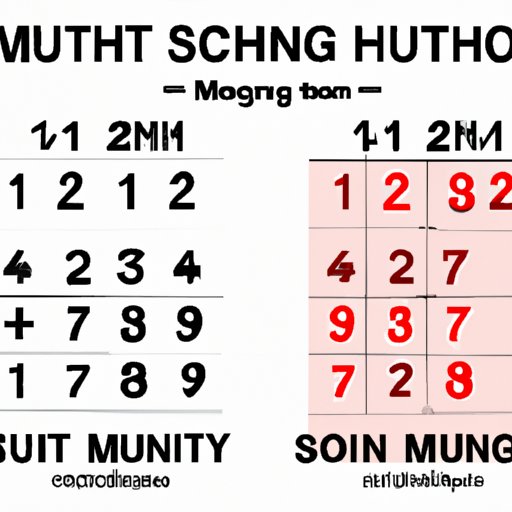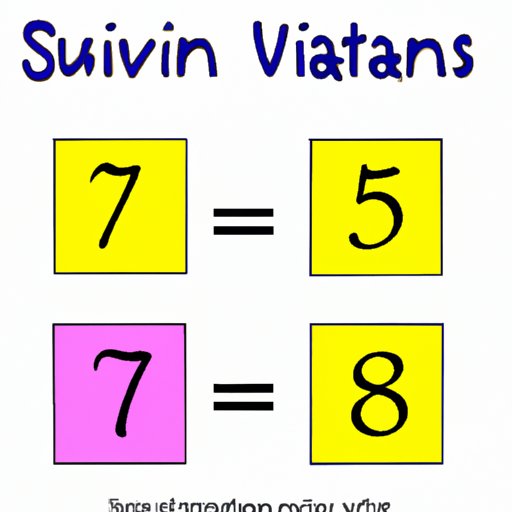
I. Introduction
When it comes to basic arithmetic operations, squaring a number is a fundamental concept that can have practical applications in many fields. The process of squaring a number involves multiplying it by itself, and can be applied to real-world scenarios such as calculating area and volume. In this article, we will explore several approaches to squaring a number, as well as the history and practical applications of this concept.
II. Step-by-Step Guide to Squaring a Number
To square a number, you simply multiply it by itself. For example, if you wanted to square the number 5, you would calculate 5 x 5, which equals 25. Let’s take a closer look at this process and break it down into steps.
A. Explanation of what squaring involves
As previously mentioned, squaring a number involves multiplying it by itself. The result is the number raised to the power of two. This concept is denoted using an exponent, as in 52 = 25.
B. Step-by-step guide with examples
The process of squaring a number can be broken down into two main steps: identifying the number to be squared and multiplying it by itself. Let’s take a look at a few examples.
1. Squaring one-digit numbers
When squaring a one-digit number, the process is quite simple. Let’s take the number 4 as an example:
- Multiply the number by itself: 4 x 4
- The result is 16, so 42 = 16
Here’s another example using the number 9:
- Multiply the number by itself: 9 x 9
- The result is 81, so 92 = 81
2. Squaring two- or three-digit numbers
Squaring numbers with two or three digits requires a bit more work, as you’ll need to break the number down into smaller parts. Let’s take the number 25 as an example:
- Break the number down into its tens and ones: 20 + 5
- Multiply each part by itself and add the results: (20 x 20) + (2 x 5 x 20) + (5 x 5) = 625
- So 252 = 625
C. Detailed explanations and examples of each step
As you can see, squaring a number involves two main steps: identifying the number to be squared and multiplying it by itself. In the case of one-digit numbers, this is a straightforward process. However, for larger numbers, you’ll need to break the number down and perform a series of operations in order to arrive at the correct answer.
III. Comparison of Different Methods of Squaring
A. Explanation of different methods for squaring
There are several methods for squaring a number, each with its own advantages and disadvantages. These include:
- Hand multiplication
- Using squares of numbers
- Completing the square
- The distributive property
B. Advantages and disadvantages of each method
The advantages and disadvantages of each method will depend on the context in which they are used. Some methods may be faster or easier to use in certain situations, while others may be more precise or accurate.
C. Comparison of methods with examples
Let’s compare the hand multiplication method with the method of using squares of numbers. For the purpose of this example, we’ll attempt to square the number 14.
- Method 1: Hand multiplication
This method involves breaking the number down into smaller parts and multiplying each part by itself before adding up the results. Here’s how it works:
- Break the number down into its tens and ones: 10 + 4
- Multiply each part by itself and add the results: (10 x 10) + (2 x 10 x 4) + (4 x 4) = 196
- Method 2: Using squares of numbers
This method involves using pre-calculated squares of numbers to simplify the process. Here’s how it works:
- Identify the nearest square of a number to 14: 122 = 144
- Calculate the difference between 14 and 12: 14 – 12 = 2
- Multiply the difference by the nearest even number: 2 x 2 = 4
- Add the result to the nearest square of a number: 144 + 4 = 148
As you can see, both methods result in the same answer (196), but the second method may be faster or easier to use in certain situations.
IV. Evolution of the Concept of Squaring a Number
A. History of how the concept of squaring evolved
The concept of squaring a number has been around for thousands of years, dating back to ancient civilizations such as the Babylonians and Egyptians. Over time, mathematicians and philosophers refined this concept and contributed to the development of modern algebra.
B. Famous mathematicians who contributed to this field
Many famous mathematicians have contributed to the development of the concept of squaring a number, including Pythagoras, Euclid, and Archimedes.
C. Examples of how squaring has been used throughout history
Squaring a number has had practical applications in many fields throughout history, such as architecture, engineering, and physics. For example, the Pythagorean theorem uses the concept of squaring to calculate the length of the sides of a right triangle.
V. Mental Math Tricks for Squaring Numbers
A. Explanation of mental math tricks for quick squaring
When it comes to mental math, there are several tricks you can use to quickly square a number in your head.
B. Examples of different tricks
Here are a few examples:
1. Multiplying by parts
This method involves breaking the number down into smaller parts and multiplying them individually. For example, to square the number 26:
- Multiply the tens: 2 x 2 = 4
- Multiply the ones: 6 x 6 = 36
- Combine the results: 4, followed by 36, equals 1,456
2. Addition and subtraction
Another mental math trick involves using addition and subtraction to quickly calculate the result. For example, to square the number 15:
- Add 1 to the first digit: 1 + 1 = 2
- Multiply the two digits: 5 x 5 = 25
- Subtract the result from step 2 from the number in step 1: 15 – 25 = -10
- Add the result from step 3 to the end of the result from step 2: 225
3. Multiplying and adding
This method involves multiplying the number by itself and then adding multiples of the number. For example, to square the number 8:
- Multiply the number by itself: 8 x 8 = 64
- Add multiple of the number: 64 + (8 x 2) = 80
C. Tips for practicing and improving mental math skills
Improving your mental math skills takes practice and repetition. Start with simple calculations and work your way up to more complex problems. Use mental math exercises and games to make learning fun and engaging. The more you practice, the easier mental math will become.
VI. Basic Arithmetic Operations: Squaring a Number
A. Brief overview of basic arithmetic operations
Basic arithmetic operations include addition, subtraction, multiplication, and division. These concepts form the foundation of mathematics and are essential for everyday life.
B. Explanation of how squaring fits into the bigger picture
Squaring a number is an example of the multiplication operation. It involves multiplying a number by itself, which is a basic arithmetic concept that can be used in many other calculations.
C. Examples of how squaring can help in other calculations
Squaring a number can help in other calculations such as calculating area and volume, as well as in trigonometry and other advanced mathematical fields.
VII. Practical Applications of Squaring Numbers
A. Explanation of real-world applications of squaring
Squaring a number has many practical applications in fields such as engineering, physics, and computer science. For example, calculating the area of a square or rectangle involves squaring one of its sides.
B. Examples in engineering, physics, and other fields
Other examples of practical applications of squaring a number can be found in fields such as physics, where it is used to calculate kinetic and potential energy, as well as in engineering, where it is used to calculate the strength and durability of structures.
C. Importance of squaring in these fields
Without the concept of squaring a number, many practical applications in fields such as engineering and physics would not be possible. Squaring a number is a fundamental concept that lays the groundwork for many mathematical and scientific fields.

VIII. Fun and Interactive Activities for Squaring Numbers
A. Explanation of fun, interactive quizzes and games
To make learning about squaring a number more fun and engaging, there are several interactive quizzes and games you can play.
B. Examples of different games/activities that teach how to square numbers
Here are a few examples:
1. Memory game
The memory game involves matching squares with the correct number and its square. This game can be played online or with a physical deck of cards.
2. Jeopardy-style quiz
A Jeopardy-style quiz involves creating a game board with categories such as “one-digit numbers” or “mental math tricks.” Students can choose which category they want to answer questions from and earn points for correct answers.
3. Interactive challenge
An interactive challenge involves setting a timer and seeing who can solve the most squaring problems in a certain amount of time. This game can be played individually or in groups.
C. Importance of making learning fun and engaging
By making learning about math fun and engaging, students are more likely to retain the information and develop a love for the subject. Interactive games and activities can help students stay focused and motivated while learning important mathematical concepts.
IX. Conclusion
A. Recap of the topics covered in the article
In this article, we explored several approaches to squaring a number, including a step-by-step guide with examples, mental math tricks, and practical applications in fields such as engineering and physics. We also discussed the history and evolution of this important mathematical concept, as well as fun and interactive activities for learning about squaring a number.
B. Suggestions for further exploration of squaring a number
For those interested in further exploring the concept of squaring a number, there are many resources available online and in print, including textbooks, worksheets, and video tutorials.
C. Encouragement for readers to continue learning about math and its practical applications
By learning about squaring a number and other mathematical concepts, you are gaining valuable skills that can be applied to many real-world scenarios.





